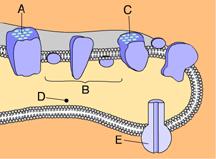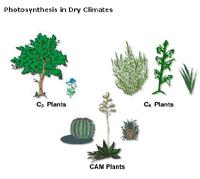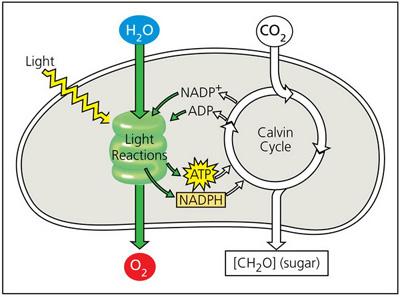_____ has a longer wavelength than _____.
Red ... green

Which of these phosphorylates ADP to make ATP?
E ATP synthase phosphorylates ADP.
_____ releases energy that is used to pump hydrogen ions from the stroma into the thylakoid compartment.
B The energy released as electrons are passed along the electron transport chain is used to pump protons into the thylakoid compartment.
_____ splits water into 1/2 O2, H+, and e- .
A Photosystem II splits water into 1/2 O2, H+, and e- .
Energized electrons from ____ enter an electron transport chain and are then used to reduce NADP+.
C
Chlorophyll can be found in _____.
A & C
In the electromagnetic spectrum, the type of radiation that we call visible light occurs between _____.
ultraviolet radiation and infrared radiation
Which of the following is a product of the light reactions of photosynthesis?
oxygen, ATP, and NADPH
When light strikes chlorophyll molecules, they lose electrons, which are ultimately replaced by _____.
splitting water
Photosynthesis is a redox reaction. This means that H2O is _____ during the light reactions and CO2 is _____ during the Calvin cycle.
oxidized...reduced
In the thylakoid membranes, what is the main role of the pigment molecules in a light-harvesting complex?
transfer light energy to the reaction-center chlorophyll
Which of the events listed below occurs in the light reactions of photosynthesis?
Light is absorbed and funneled to reaction-center chlorophyll a.
Assume a thylakoid is somehow punctured so that the interior of the thylakoid is no longer separated from the stroma. This damage will have the most direct effect on which of the following processes?
the synthesis of ATP the synthesis of ATP
What does the chemiosmotic process in chloroplasts involve?
establishment of a proton gradient across the thylakoid membrane
In a plant cell, where are the ATP synthase complexes located?
thylakoid membrane and inner mitochondrial membrane
Which of the following statements best describes the relationship between photosynthesis and respiration?
Photosynthesis stores energy in complex organic molecules, whereas respiration releases it.
In photosynthetic cells, synthesis of ATP by the chemiosmotic mechanism occurs during
both photosynthesis and respiration.
Reduction of oxygen to form water occurs during
respiration only.
look at item 15
item 15
Which statement correctly describes how O2 production would be affected? (Assume that the light intensity does not change.)
The rate of O2 production would decrease because the rate of ADP and NADP+ production by the Calvin cycle would decrease.
Which process produces oxygen?
Photosynthesis Oxygen is a by-product of the photosynthetic process.
Which set of reactions uses H2O and produces O2?
The light-dependent reactions
What is the importance of the light-independent reactions in terms of carbon flow in the biosphere?
The light-independent reactions turn CO2, a gas, into usable carbon in the form of sugars.
True or false? The light-dependent reactions of photosynthesis use water and produce oxygen.
True
Which of the following molecules is the primary product of photosystem I?
NADPH note: The NADPH produced by photosystem I is used to supply energy for the production of sugars during photosynthesis.
What is the biological significance of the light-independent reactions of photosynthesis?
They convert carbon dioxide to sugar.
Which of the following statements best describes the relationship between the light-dependent and light-independent reactions of photosynthesis?
The light-dependent reactions produce ATP and NADPH, which are then used by the light-independent reactions.
Which of the following reactions ensures that the Calvin cycle can make a continuous supply of glucose?
Regneration of RuBP
Which of the following products of the light reactions of photosynthesis is consumed during the Calvin cycle?
NADPH
The overall function of the Calvin cycle is _____.
making sugar

In C3 plants the conservation of water promotes _____.
photorespiration
In C4 and CAM plants carbon dioxide is fixed in the _____ of mesophyll cells.
cytoplasm
C4 plants differ from C3 and CAM plants in that C4 plants _____.
transfer fixed carbon dioxide to cells in which the Calvin cycle occurs
C4 plants occur more commonly in desert conditions because _____.
they can fix carbon at the lower CO2 concentrations that develop when the stomata are closed
CAM plants keep stomata closed in daytime, thus reducing loss of water. They can do this because they
fix CO2 into organic acids during the night.
The alternative pathways of photosynthesis using the C4 or CAM systems are said to be compromises. Why?
Both minimize photorespiration but expend more ATP during carbon fixation.
Plants photosynthesize only in the light. Plants respire
both in light and dark.
The light reactions of photosynthesis supply the Calvin cycle with
ATP and NADPH.
Which of the following sequences correctly represents the flow of electrons during photosynthesis?
H2O → NADPH → Calvin cycle
How is photosynthesis similar in C4 plants and CAM plants?
In both cases, rubisco is not used to fix carbon initially.
Which of the following statements is a correct distinction between autotrophs and heterotrophs?
Autotrophs, but not heterotrophs, can nourish themselves beginning with CO2 and other nutrients that are inorganic.
Which of the following does not occur during the Calvin cycle?
release of oxygen
Select the correct molecule that is the main product of the Calvin cycle.
G3P
In mechanism, photophosphorylation is most similar to
oxidative phosphorylation in cellular respiration.
Which process is most directly driven by light energy?
removal of electrons from chlorophyll molecules
What is the basic role of CO2 in photosynthesis?
CO2 is fixed or incorporated into organic molecules.

Select the most accurate statement describing the basic function of the light reactions of photosynthesis.
The basic function of the light reactions of photosynthesis is the conversion of solar energy to chemical energy.
Select the correct statement about the Calvin cycle.
The Calvin cycle has three phases: carbon fixation, reduction, and regeneration of RuBP.
Why are plants classified as producers?
Plants are classified as producers because they fix inorganic carbon into organic molecules.